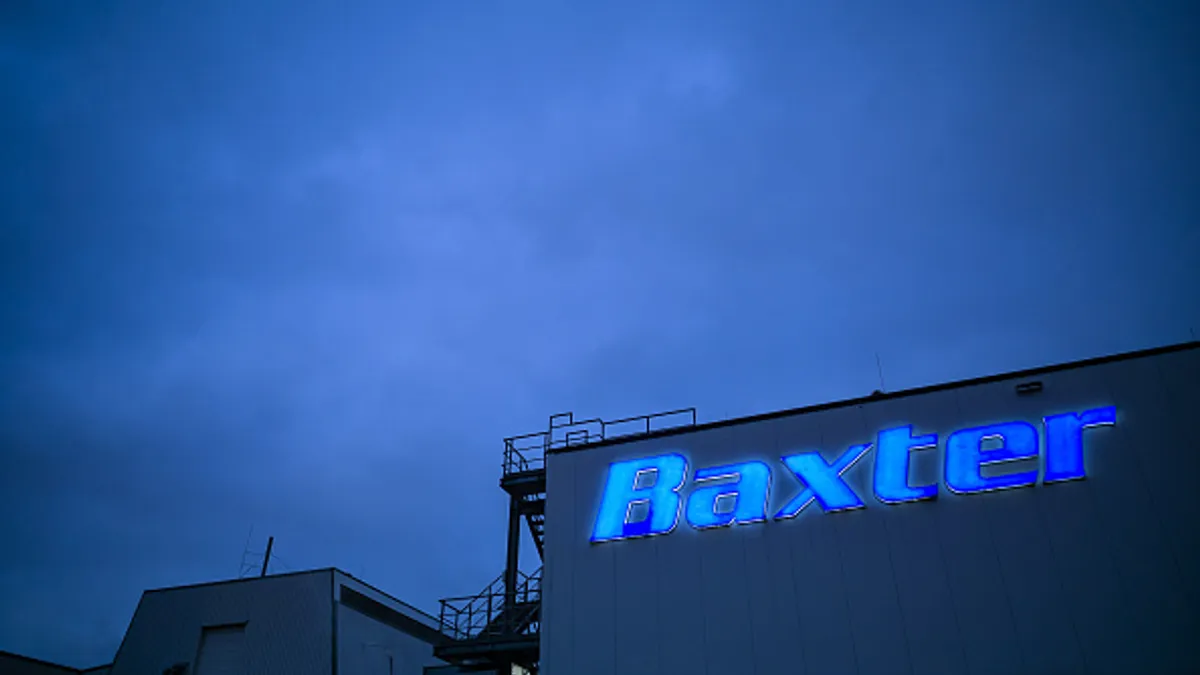Dive Brief:
- Baxter increased its forecast for cost synergies from its $10.5 billion takeover of Hillrom announced in late 2021. The company now expects its pretax cost savings to rise to $300 million by 2024 compared to its original estimate of $250 million. The firm also said it should "realize up to $200 million in incremental annual revenue synergies" by 2025 and sales growth of 4% to 5% on a compounded annual basis from 2022 through 2025.
- Baxter executives, speaking to analysts at an investor conference on Wednesday, said the additional cost synergies — now forecast to reach $350 million by 2025 — emerged as the company took a closer look at Hillrom’s footprint such as real estate.
- Baxter shares gained about 2% on the revised forecast. Analysts at J.P. Morgan said Baxter “made a compelling argument for why its strategic vision for the company over the next 3+ years warrants a second look from investors.”
Dive Insight:
Some analysts initially questioned the price and strategic fit of a Baxter-Hillrom deal. J.P. Morgan noted before the acquisition was announced that it's “not the deal we want to see." Ten months later after the deal was made, Baxter at its 2022 investor conference provided new guidance on expected synergies from the takeover, allaying some concerns.
Analysts at Evercore ISI said the forecast of $200 million in revenue synergies from the Hillrom deal was an “upside surprise.” About 75% of the forecast sales synergies are expected to come from market expansion.
Baxter CFO Jay Saccaro said on the call that market expansion was “a real opportunity” for the company, explaining that there are chances to move products between geographies and channels to drive growth. According to a Wednesday note from Evercore, the remainder of the Hillrom revenue synergies are expected to come from tech services.
The expansion of markets where Baxter has a presence will also shape the company’s approach to mergers and acquisitions in the coming years, according to CEO José Almeida.
“Our markets have expanded quite a bit with the acquisition of Hillrom, creating opportunity for adjacencies that were not here before," Almeida said on the call. "We're going to get into M&A again. Cardiology is one of (the adjacencies).” The CEO also cited decision support systems and point-of-care diagnostics as areas Baxter may look at as the company seeks to expand its market to increase its growth rate.
Analysts at J.P. Morgan expect Baxter’s deal-making to be limited to tuck-in acquisitions over the next 12 to 18 months, adding that they “don’t view Baxter as the most active company on the tuck-in front.”
Still, “with further strategic exits from businesses with lower long-term strategic fit also likely,” the analysts see opportunities for acquisitions to increase Baxter’s growth rate over the next few years.
While Baxter's forecasts for cost savings will support the expansion of the company's operating margin, macro headwinds mean the push may get off to a slow start, according to Saccaro.
“It's not a linear progression. In 2023, there are some overhangs that continue to exist with respect to inflation, with respect to the supply of critical raw materials that we've assumed in our numbers. So, we anticipate a minimum of 75 basis points in a given year, totaling 350 to 400 basis points by 2025,” Saccaro said.
Analysts at J.P. Morgan said the comment suggests Baxter’s earnings-per-share forecast for 2023 will come in a “step below” the current analyst consensus.
Correction: A previous version of this article misstated the date of Baxter's investor conference, which was Wednesday, May 25.












